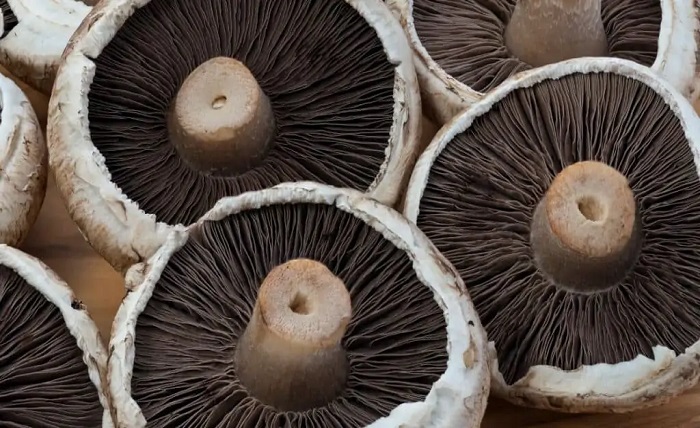Portobello mushrooms are a popular and versatile ingredient that can be used in salads, sandwiches, pizzas, soups, and more. They are large, brown, and meaty, with a rich and earthy flavor. But are they safe to eat raw or cooked? What are the potential risks and benefits of consuming portobello mushrooms? In this article, we will answer these questions and provide some tips on how to enjoy portobello mushrooms without any worries.
What are Portobello Mushrooms?
Portobello mushrooms are the mature form of the common mushroom (Agaricus bisporus), which is also known as white button mushroom or crimini mushroom. They belong to the Agaricaceae family of fungi, which includes edible and poisonous species. Portobello mushrooms are native to grasslands in Eurasia and North America, but they are cultivated in more than 70 countries. They have a cap that is 5-10 cm in diameter, with dark brown scales on a paler background. The gills are free and initially pink, then red-brown, and finally dark brown. The stem is cylindrical and has a ring around it. The flesh is white and firm, but it turns pinkish-red when bruised
Are Portobello Mushrooms Poisonous?
Portobello mushrooms are not poisonous, but they can be confused with some deadly or inedible lookalikes. For example, some species of Amanita, known as destroying angels, have a similar appearance but have a cup-like structure at the base of the stem and pure white gills. These mushrooms contain a toxin called amatoxin, which can cause liver failure and death if ingested. Another species that can be mistaken for portobello mushrooms is Agaricus xanthodermus, which has a phenolic odor and yellow flesh when bruised. This mushroom can cause nausea and vomiting in some people. Therefore, it is important to identify portobello mushrooms correctly before eating them. Some features that can help distinguish them from their lookalikes are:
- The absence of a cup or volva at the base of the stem
- The presence of a ring around the stem
- The color change of the gills from pink to brown
- The lack of a phenolic odor
- The absence of yellowing when bruised
Are Portobello Mushrooms Healthy?
Portobello mushrooms are low in calories and fat, but high in protein, fiber, vitamins, minerals, and antioxidants. They contain vitamin B2, B3, B5, B6, B9, C, D2, K1, copper, selenium, potassium, phosphorus, iron, zinc, manganese, and ergothioneine. These nutrients can support various aspects of health such as:
- Immune system function
- Energy production
- Nerve health
- Blood formation
- Bone health
- Skin health
- DNA synthesis
- Antioxidant defense
Portobello mushrooms also contain beta-glucans, which are polysaccharides that have immunomodulatory, anti-inflammatory, anti-diabetic, anti-obesity, and anti-cancer properties. Beta-glucans can stimulate the activity of macrophages, natural killer cells, dendritic cells, and T cells, which are involved in fighting infections and tumors. They can also lower blood glucose levels by slowing down carbohydrate digestion and absorption. Furthermore, they can reduce body weight by increasing satiety and reducing food intake. Additionally, they can inhibit the growth and spread of cancer cells by inducing apoptosis (cell death) and preventing angiogenesis (blood vessel formation).
How to Eat Portobello Mushrooms Safely?
Portobello mushrooms can be eaten raw or cooked, but there are some precautions that should be taken to ensure their safety and quality. Here are some tips on how to eat portobello mushrooms safely:
- Wash them thoroughly before eating or cooking them. Portobello mushrooms can harbor dirt, bacteria, pesticides, or other contaminants that can cause food poisoning or allergic reactions.
- Remove the stem and gills if desired. The stem can be tough and fibrous, while the gills can release a dark liquid that can stain other ingredients. However, both parts are edible and nutritious.
- Cook them properly if you prefer them cooked. Cooking portobello mushrooms can enhance their flavor and texture, as well as reduce their potential toxicity. Some studies have shown that raw mushrooms contain small amounts of agaritine, which is a carcinogenic compound that can be converted into hydrazine, which is a toxic substance that can damage DNA. Cooking can reduce the amount of agaritine and hydrazine in mushrooms by up to 90%.
- Store them properly after buying or harvesting them. Portobello mushrooms can spoil quickly if not stored properly. They should be kept in a paper bag or a perforated plastic bag in the refrigerator. They should not be washed until ready to use, as moisture can speed up their deterioration. They should be consumed within a few days of purchase or harvest.
Conclusion
Portobello mushrooms are a delicious and nutritious food that can be enjoyed raw or cooked. However, they can also be confused with some poisonous or inedible lookalikes, so it is important to identify them correctly before eating them. They should also be washed, cooked, and stored properly to ensure their safety and quality. By following these tips, you can enjoy portobello mushrooms without any worries.





